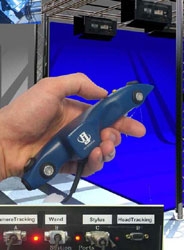 |
Abstract: Enhancing Perspicuity of Objects in Virtual Reality Environments
Jens Herder and Michael Cohen. Enhancing Perspicuity of Objects in
Virtual Reality Environments CT'97 - Second International
Cognitive Technology Conference, Aizu, pp. 228-237, IEEE Press, ISBN 0-8186-8084-9, August 1997.
In an information-rich Virtual Reality (VR) environment, the user is
immersed in a world containing many objects providing that
information. Given the finite computational resources of any computer
system, optimization is required to ensure that the most important
information is presented to the user as clearly as possible and in a
timely fashion. In particular, what is desired are means whereby the
perspicuity of an object may be enhanced when appropriate. An object
becomes more perspicuous when the information it provides to the user
becomes more readily apparent. Additionally, if a particular object
provides high-priority information, it would be advantageous to make
that object obtrusive as well as highly perspicuous. An object becomes
more obtrusive if it draws attention to itself (or equivalently, if it
is hard to ignore). This paper describes a technique whereby objects
may dynamically adapt their representation in a user's environment
according to a dynamic priority evaluation of the information each
object provides. The three components of our approach are:
- an information manager that evaluates object information priority,
- an enhancement manager that tabulates rendering features
associated with increasing object perspicuity and obtrusion as a
function of priority, and
- a resource manager that assigns available object rendering
resources according to features indicated by the enhancement
manager for the priority set for each object by the information
manager.
We consider resources like visual space (pixels), sound spatialization
channels (mixels), MIDI/audio channels, and processing power, and
discuss our approach applied to different applications. Assigned
object rendering features are implemented locally at the object level
(e.g., object facing the user using the billboard node in VRML 2.0)
or globally, using helper applications (e.g., active spotlights,
semi-automatic cameras).
Keywords:
perspicuity, obtrusion, virtual reality, spatialization,
spatial media, autonomous actors, user interface design,
man-machine interfaces
Copyright
Copyright 1997 IEEE. Published in the Proceedings of CT'97,
August 25-28, 1997 in Aizu, Japan. Personal use of this material
is permitted. However, permission to reprint/republish this
material for advertising or promotional purposes or for creating
new collective works for resale or redistribution to servers or
lists, or to reuse any copyrighted component of this work in
other works, must be obtained from the IEEE. Contact: Manager,
Copyrights and Permissions / IEEE Service Center / 445 Hoes Lane
/ P.O. Box 1331 / Piscataway, NJ 08855-1331, USA. Telephone: +
Intl. 908-562-3966.
|
 |
